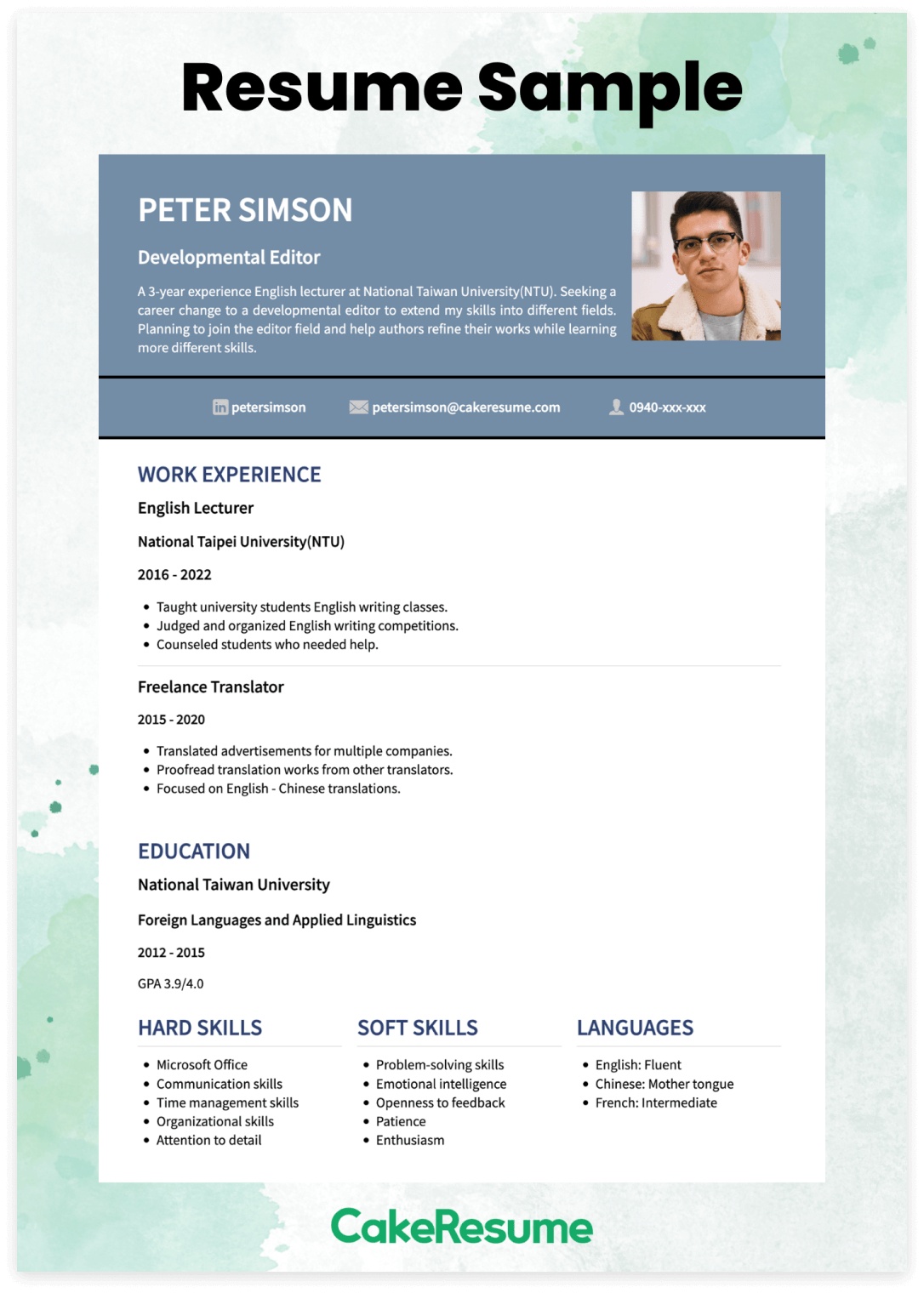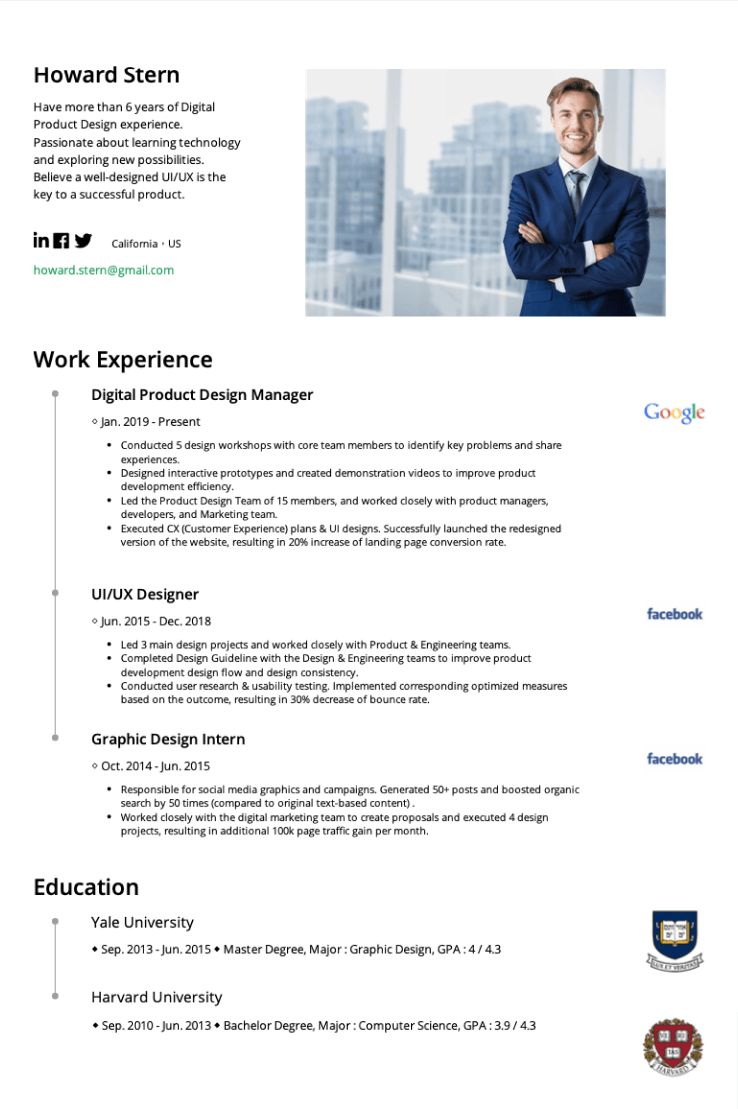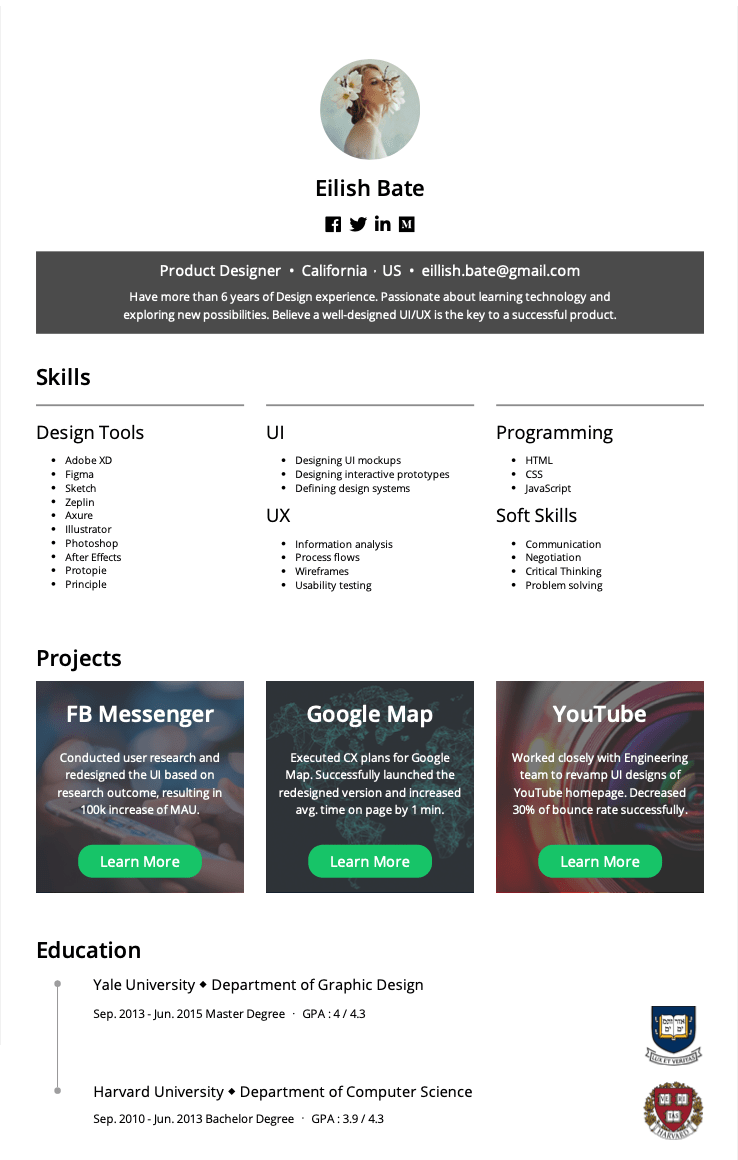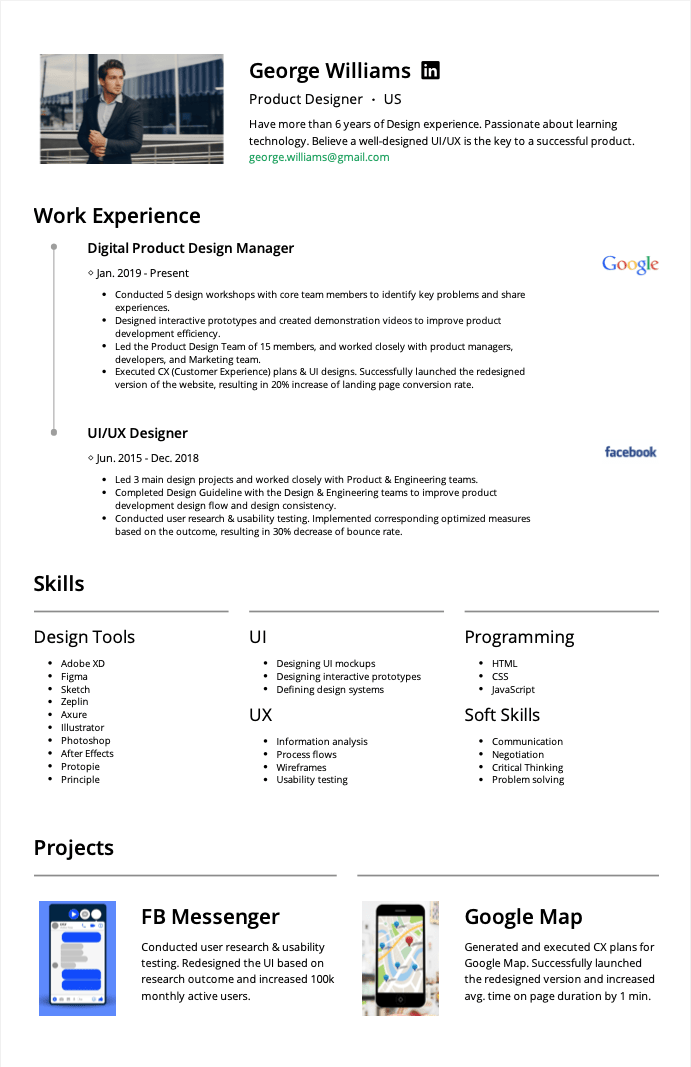What Is a Resume: Resume Formats, Resume Elements, Resume Writing Tips

A resume, also known as a Curriculum Vitae (CV), is a necessary formal document for job seeking process. A strong resume can help grab the attention of employers and can be the key to landing an interview. But "what is a resume?" you might ask. In this blog post, we'll share with you all-thing resumes, from its definition and types to writing tips and best practices for creating a compelling one, whether you are a recent graduate or already an experienced professional, or even someone who wants to transition to a new career, this blog will provide you with the essential knowledge and resume builder tools to create a standout resume.
So, let's dive into it!
TABLE OF CONTENTS
Resume Definition
The term resume (or résumé) is a French-derive word that means a summary, and that's essentially what a resume is: a one-page document summarizing applicants' skills, work experience, educational background, and information that are relevant to the job you're applying for.
With that being said, “what is the primary purpose of a resume,” then, you might ask?
Straightforwardly, a resume is often used to help you get a job, isn't it? True, but not really. While it won't guarantee employment, a well-crafted resume can help you secure an interview by showcasing your skills and qualification. This one-page document is your opportunity to make a positive first impression, sell yourself, and convince your potential employers that you're the most suitable candidate for the vacancy, as well as demonstrate what you can bring to the table.
Although it's recommended to tailor your resume to each job you apply for, some core elements should always be present. Now that we're understand the resume definition, let's further delve into these components and explain why they're crucial for creating an effective resume.
Resume vs. CV: What Are the Main Differences?
In some countries, the term "resume" is often used interchangeably with "curriculum vitae" (CV) despite their slight differences: while a resume is a summary of your relevant skills and qualifications for a particular position, a CV is more about your course of life as it contains a detailed academic record that includes all of your professional experiences, certifications, publications, and achievement.
A simpler curriculum vitae's definition is that CVs are commonly used by those pursuing fellowships, grants, postdoctoral positions, teaching or research positions at the post-secondary level, or in high-level research positions in the industry. While graduate school applications may request a CV, they generally prefer a resume that includes details of research projects and publications.
Suppose you plan to apply for both academic and private or public sector industries; you'll need to create both documents. If you're unsure which document to submit for a job application, it's always best to ask for clarification.
Resume Formats and How to Choose the Best One
There are three main resume formats: reverse chronological, functional, and combination resumes. Let's break down the definition of each so that you can pick the most suitable format that suits your needs best.
1. Reverse chronological resume
A reverse chronological resume is a resume format that lists your work experience from the latest to the oldest. By highlighting the most recent experience, employers can check if you've been working in the same industry or a similar position so that they can save training effort after hire. The more relevant you are, the more competitive edge you gain.

If you've been working for different jobs and have a lot of work experience, a reverse chronological resume is the way to go.
Pros:
- Recruiters often are familiar with this resume format.
- Recruiters can scan through the highlighted professional experience more easily.
- Showcases the most recent work experience that they are looking for.
Cons:
- The layout and format are commonly used, which makes it hard to stand out, especially in the creative industry.
- Not much emphasis on one’s relevant skills and capabilities.
- Job-changing histories and employment gaps are accentuated.
2. Functional resume
If you want to highlight your skills, then a functional resume format is what you should consider. Instead of focusing on the work experience, a functional resume helps highlight your skills and how they'll benefit the job you're applying for.

Unlike the chronological resume format, the functional one lists your skills as the body, while work experience and other information come after the skills. One tip for writing an effective functional resume is that the detail of the skills mentioned should also be included as sub-points. If you're a job hopper or someone who's planning to change careers and industries or has an employment gap that you prefer not to show the employer, a functional resume will be the perfect choice for you.
Pros:
- Recruiters will know your skills and how they can benefit the company.
- Hide employment gaps.
- De-emphasize the job hopping scene, which can negatively impact recruiters' decisions.
- Flexible as you can make more subtle changes.
Cons:
- Might draw employer’s attention to the covered-up work experience.
- Cannot show career growth.
- Recruiters might not be familiar with the format.
3. Combination resume
Just like the name indicates: a combination resume is a combined resume format of chronological and functional resume, which includes the details of work experience and relevant skills.

This type of resume format is very flexible as it allows you to adjust to the job vacancy's requirements. It doesn't matter if you have much or negligible working experience; this hybrid resume format can balance out the information to present yourself better.
Pros:
- Allows you to utilize your information to the needs of a position fully.
- Allows you to avoid including employment gaps.
- Can impress employers with detailed qualifications and skills.
Cons:
- Career growth is not shown at first sight.
- The design might be overcrowded if the layout is not well-crafted.
- Traditional employers might not accept it.
Resume Elements: What to Include and What not to
Since a resume is your representation before you even meet the employers in real-life, knowing what to include in it will be highly beneficial.
Here is the list of essential elements to include in your resume:
Here are the essential elements that your need to have on a resume:
Contact details
Your contact details must always lie at the beginning of your resume. This includes your phone number and email address so that employers can contact you if they need any further information or contact you.
💡 Pro tip: Avoid using inappropriate email addresses if you want to look professional in the recruiters' eyes.
Introduction
A strong introduction can turn heads; it can be a simple sentence or a short paragraph describing who you are. Although some people might include their career goals in the intro section, you don't have to do it if the information doesn't deliver any impactful message.
💡 Pro tip: Avoid vague statements; if you have nothing significant to share about your career objectives, don't mention it.
Educational background
If you are a fresher, your educational background will be fundamental as it helps recruiters to have a general idea of who you are, based on your majors and GPA/grades.
When listing education in your resume, include the school name, the attendance year, degree, and GPA.
💡 Pro tip: Only include your GPA if it is above 3 or 3.5.
Experience
When employers look at the work experience section, they usually look at these three key parts: your job title, the company you've worked for, and the working period. But extra information about your responsibilities will help. For example, you helped your previous employers acquire 10,000 potential customers from its latest attended conference; hence, you might want to briefly introduce the event and what you've done to achieve those numbers.
💡 Pro tip: Make sure to mention your job responsibilities, notable achievements, and milestones, and back them up with some numeric data for better illustration.
Skills
Having attention-grabbing skills can make your resume stand out, but it's important to know that skills can be categorized into two types: hard and soft skills.
Hard skills are technical knowledge that you can learn and train. The proficiency level of hard skills is usually measurable; for example, software skills relevant to your job are considered hard skills.
Meanwhile, soft skills are personality traits that make you a good fit for the position. Since these are subjective traits, they can be more difficult to measure in terms of proficiency. Examples of soft skills include leadership, communication, and teamwork.
Certifications & licenses
Jobs like accountant, teacher, and civil engineer require official certifications or licenses. If you are applying for jobs with high-level education requirements, this information shows your credibility.
Language skills
Being bilingual or multilingual is beneficial because employers want someone who can represent the company overseas or work with foreign partners and clients. Listing any language skills you have on your resume is a huge plus. Don't forget to include your proficiency level: native, bilingual proficiency, professional working proficiency, or elementary level.
Awards & honors
Awards and honors from competitions can be an impressive addition to your resume, especially if you’re a fresh graduate looking for a job. If you received any awards or honors for either outstanding academic or non-academic performance, mention them both.
Volunteer
Volunteer work shows your kind-hearted personality and how you apply certain skills to practice. You can list volunteer work experiences on your resume and details of what you've done. Remember that the skills applied in volunteer work should be related to the position you're applying for.
Publications
If you've written a thesis, contributed to a journal or research, or published books, articles, or news, you can provide information about these publications on your resume. This illustrates professional knowledge of a certain topic and can be part of your portfolio.
Projects
Listing projects you've worked on is a good way for employers to know what you've achieved and how you've applied your skills in practice. This gives them a better understanding of your level of experience.
The Best Resume Templates
When it comes to applying for a job, a well-crafted resume can be the key to standing out among other applicants. The layout and design of a resume can make a significant difference in how potential employers receive it. Therefore, it's crucial to choose a resume template that is both visually appealing and functional.
The best resume templates must highlight your skills and experience while presenting the information in a clear and easy-to-read format. They typically include sections for your education, work experience, skills, and accomplishments. Whether you're looking for a modern, creative, or traditional design, numerous resume templates available online can help you create a standout resume.
Discover an extensive collection of customized resume examples and formats that fit your professional path. CakeResume offers thousands of options for you to find the perfect ones and showcase your skills, experience, and achievements. These templates are designed to cater to various industries and job roles, ensuring that you can find the ideal ones to make your resume stand out from the competition. Explore this vast selection of resume examples and formats to find the one that best represents your unique career profile.
5 Writing Tips for a Good Resume
Here are some tips that not only create an outstanding resume but will also help you look good on a resume:
1. Customize your resume to match the job description
While your resume is meant to showcase who you are as a potential employee, employers also have specific requirements they seek in candidates. As such, it's crucial to tailor your resume to include relevant information that aligns with the job description while excluding those that don't.
2. Proofread again and again
Given the high number of resumes that hiring managers receive, they can easily spot even the slightest error. Thus, to avoid such mistakes, always proofread your resume before submitting it.
3. Utilize action words
Action words are constructive in showcasing what you have done in previous jobs. Thus, utilizing them when highlighting your skills and achievements is advisable as they can significantly impact how employers view and understand you.
4. Use relevant keywords
For big companies that receive thousands of resumes, Applicant Tracking Software (ATS) can help filter out applications by identifying keywords that match the job requirements. Therefore, incorporating relevant keywords is crucial. The best way to identify relevant keywords is by referring to the job description for skill-related keywords and incorporating them accordingly.
5. Maintain a clean and well-organized resume format
A well-organized resume format can enhance readability and help hiring managers locate information quickly. Here are some guidelines to follow:
- Maintain 1-inch margins on all sides of the document.
- Use an appropriate font size (11pt or 12pt) and style.
- Group related information under different sections for better viewing.
- Use bullet points to highlight key details.
Example of a Resume
Now that you know what to include in a resume, all about resume templates and format, it’s time for us to show you what a concise resume should look like! Check this out:
Peter Simson
Developmental Editor
098-1234567
Taoyuan city
[email protected]
RESUME SUMMARY
A 3-year experience English lecturer at National Taiwan University(NTU). Seeking a career change to a developmental editor to extend my skills into different fields. Planning to join the editor field and help authors refine their works while learning more different skills.
WORK EXPERIENCE
English Lecturer
National Taipei University (NTU)
2016 - 2022
- Taught university students English writing classes.
- Judged and organized English writing competitions.
- Counseled students who needed help.
Freelance Translator
2015 - 2020
- Translated advertisements for multiple companies.
- Proofread translation works from other translators.
- Focused on English - Chinese translations.
EDUCATION
National Taiwan University (NTU)
Foreign Languages and Applied Linguistics
2012 - 2015
GPA 3.9/4.0
SKILLS
Hard Skills:
- Microsoft Office
- Communication skills
- Time management skills
- Organizational skills
- Attention to detail
Soft Skills:
- Problem-solving skills
- Emotional intelligence
- Openness to feedback
- Patience
- Enthusiasm
Language Skills:
- English: Fluent
- Chinese: Native
- French: Intermediate
Key Takeaways
Now that you know the resume definition, here are some key takeaways that you should keep in mind: a resume is a critical document that summarizes your education, work experience, skills, and achievements. It is an essential tool that helps you present yourself to potential employers and showcase your suitability for a specific job position. The information presented in your resume should be tailored to the job description to demonstrate how you can add value to the organization.
CakeResume is a free online resume builder that is useful for anyone looking to create an online presence, whether you’re a recent graduate, a freelancer, or an established professional looking to showcase your work. With the help of CakeResume’s rich library of resume templates and online resources, crafting an outstanding, ATS-friendly resume has never been easier. Following the tips and guidelines outlined in this blog, you can create a compelling resume highlighting your unique skills and experience, increasing your chances of landing your dream job.
CakeResume is the best free resume builder that allows users to create professional online resumes and portfolios, which can also serve as personal web pages. With its simple and intuitive interface, users can effortlessly build their professional online resumes and portfolios and showcase their skills and accomplishments to potential recruiters and employers.
--- Originally written by Ryan Goh ---
Tentang Karir dan Tips Loker

With the intention of helping job seekers to fully display their value, CakeResume creates an accessible free resume/CV/biodata builder, for users to build highly-customized resumes. Having a compelling resume is just like a piece of cake!







